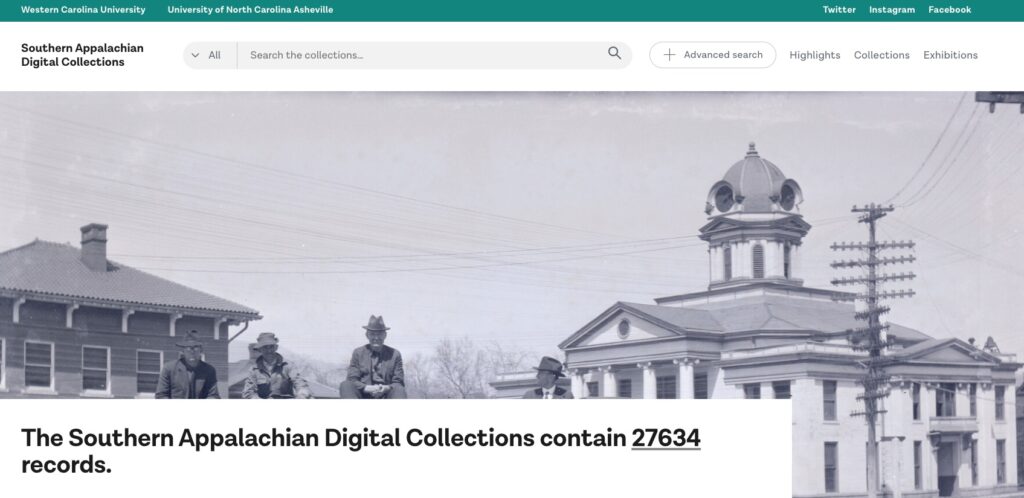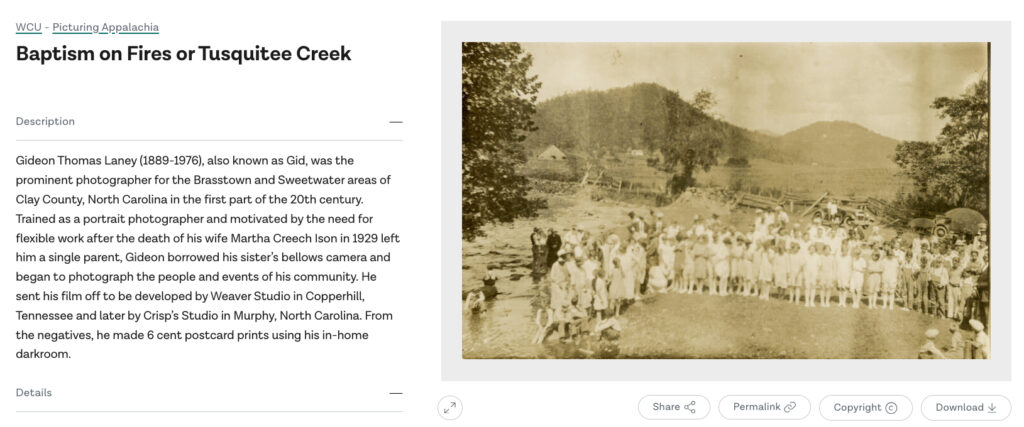This article appeared in the Volume 4, Issue 3 Winter 2024 issue of the Appalachian Curator. Click here to view a PDF of the full issue.
By Kellen Carpenter, Digital Scholarship Librarian, Western Carolina University
Currently, the digital assets of Special Collections at Western Carolina University (WCU) and the University of North Carolina and Asheville (UNCA) live together on the website of the Southern Appalachian Digital Collections Partnership alongside the bold mission statement that declares: “The Southern Appalachian Digital Collections Partnership was founded in 2019 to host centralized online access to unique regionally focused digitized materials that document the history and culture of Southern Appalachia.” It’s a mission statement that gestures at a recent history of change and hints at bigger plans for the future.

In 2019, Western Carolina University and the University of North Carolina at Asheville formed a partnership to consider a joint solution for managing and displaying digital assets created by the Special Collections department within each institution’s library. While both universities had been independently pursuing a program of digitization within their Special Collections, neither was satisfied with the way they were organizing and displaying these digitized items. Leveraging the existing relationship between WCU and UNCA libraries that exists as part of the Western North Carolina Library Network (WNCLN), the two institutions agreed to pursue a tighter partnership and a joint platform for digital assets. With the help of a Library Services and Technology Act (LSTA) Grant, the libraries were able to hire a consultant to help define a specification of what the libraries needed out of a digital platform, a plan for soliciting and evaluating potential vendors, and a general plan of attack.
This strategy led the partnership to Qi, a content and collections management platform that was primarily used by museums and galleries and had seen little adoption and use in library special collections. Qi, however, met our specification better than a lot of products and platforms explicitly aimed at archives and libraries. The developer of Qi, Keepthinking, agreed to work with us to customize the platform configuration and develop a website to effectively showcase our materials.

As with any large-scale migration, moving existing digital assets onto the new platform was a massive undertaking. All-told, over 25,000 items, including images, pdfs, audio and video files were extracted from the older system and eventually ported over to Qi. Of course, the process of moving all of your stuff at once only brings into stark relief the inconsistencies of process and naming that creep in during a decades old digitization program. While migration is a challenge, it is also a golden window to make changes, and the opportunity to conduct significant metadata remediation was hard to pass up: If you’re moving all your boxes from one house to another, you might as well correct the labels on the boxes while you’ve got your hands on them. That’s a metaphor that probably doesn’t give enough credit to the effort and work behind such a massive metadata cleanup.
From the beginning of the development process, the Southern Appalachian Digital Collections (SADC) Partnership was never intended to only include WCU and UNCA. Even as early as picking the name, the partnership aimed to be a potential gateway and destination for the whole southern Appalachian region and not just western North Carolina. With that in mind, the website and underlying back-end organization of Qi were designed to accommodate multiple institutions. While the holdings of a given institution can still be searched for and viewed separately from the holdings of other institutions, the shared repository means that materials on a shared topic, person, or place are easily viewable alongside each other, regardless of the parent institution. The presumptive end-goal has always been a platform that transcended the individual founding institutions and placed the spotlight on the region’s history and culture. To that end, the SADC Partnership is seeking partners to grow and expand.

With WCU and UNCA established with the SADC, it’s time that the partnership takes a wider view of the natural and cultural heritage landscape of the region and begin to grow. The partnership offers a way for organizations of the region, particularly smaller ones, to share group purchasing power tor licensing the Qi content management system, share digitization capabilities, and share staff expertise. While collective cost-sharing is at the root of this partnership, the active operating principle is intended to be one of cooperation and mutual aid. Prospective member institutions should reside within Southern Appalachia (Western North Carolina, North Georgia, Eastern Tennessee, South Carolina, Southwest Virginia); have a mission to support and preserve the literature, culture, music, or historical heritage of the region; contribute collections to digitize and/or accession into the shared content management system; and commit to pay annual fees and proportional costs of joint projects.
Any library, archive, museum, or other cultural heritage institution that meets these criteria and has the relevant collections, staffing, and structure to contribute to the partnership should consider the SADC as way to effectively publish digital assets online and spread their reach. A steering committee composed of representatives of all member institutions provides guidance for future projects and growth of the SADC partnership in an egalitarian and democratic decision-making and governance process.

Importantly, the SADC website and underlying content-management system are continually being improved. The Qi platform is being actively developed and the SADC has witnessed several dramatic quality-of-life improvements implemented. In addition to a responsive developer and an active user’s group, the SADC partnership has actively sought to fund development of features specific to the partnership’s needs. This emphasis on infrastructure and design has left the SADC with a blueprint for growth and the space and structure to welcome new members. With its focus on collaboration and cooperation, the Southern Appalachian Digital Collections Partnership stands ready to continue its mission of building regionally oriented, historically significant collections of broad cultural and research interest extend online access to unique resource materials of the natural and cultural history of the Southern Appalachian region.